Author: ASXN
Translation: Golden Finance xiaozou
1. Introduction
Throughout history, the continuous evolution of currency has been driven by the need to fulfill three core functions: medium of exchange, store of value, and unit of account. The relentless pursuit of faster settlement, lower costs, and borderless availability has propelled the development from local barter systems to today’s global digital networks. Stablecoins represent a new phase in the evolution of currency and payments, establishing the foundation for a financial system characterized by faster settlement, lower fees, seamless cross-border functionality, native programmability, and strong auditability.
The demand for dollar stablecoins is robust across a range of use cases, including store of value, cross-border remittances, payments, yield generation, and trading, and they are increasingly viewed as strategic tools by governments and treasuries. Beyond their digital financial utility, they are becoming shadow monetary policy tools for managing sovereign debt and expanding the global influence of national currencies and financial systems.
In the context of an improving regulatory environment, evolving U.S. debt dynamics, and technological advancements, we predict that the market capitalization of stablecoins will reach approximately $4.9 trillion over the next decade, expanding nearly 20 times from current levels.
Plasma is a customized L1 public chain optimized for stablecoins. As stablecoins continue to penetrate globally, we believe Plasma will fully capitalize on this macro trend by providing highly customized infrastructure for payments, remittances, fiat channels, foreign exchange, and DeFi.
2. Stablecoins
Stablecoins are on-chain representations of fiat currencies (primarily the U.S. dollar). Essentially, they encapsulate the dollar in software, allowing it to flow at the speed of light anywhere the internet reaches. In short, stablecoins are the fastest existing form of the dollar. Their market size has expanded from just $30 million in total market capitalization in 2018 to over $250 billion today, with a compound annual growth rate of 263%. Initially used as crypto-native collateral and settlement mechanisms (especially by market makers and arbitrageurs), stablecoins have now evolved into widely adopted financial primitives.
The current stablecoin ecosystem includes several main types, primarily distinguished by the type of collateral backing, degree of decentralization, and mechanisms for maintaining the peg. Fiat-collateralized stablecoins dominate the market, accounting for over 92% of total market capitalization. We categorize them as follows:
Fiat-Collateralized — These stablecoins provide full collateralization for each token by holding an equivalent amount of fiat currency off-chain, maintaining a 1:1 peg. For example, each USDC token is backed by $1 in a combination of cash and short-term U.S. government debt. According to the latest reserve report, each USDC is supported by approximately $0.885 in U.S. Treasuries and $0.115 in cash. Specific entities can mint and redeem fiat-collateralized stablecoins, maintaining the token's peg to $1 through arbitrage mechanisms. The primary revenue source for fiat-collateralized issuers comes from allocating reserves to interest-bearing U.S. Treasury instruments. For instance, Tether is projected to profit about $7 billion in 2024 through holding U.S. Treasuries and repurchase agreements.
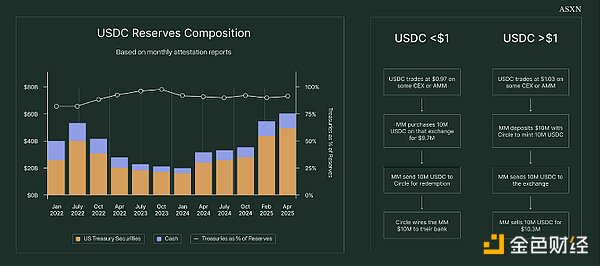
Crypto-Asset Collateralized — Crypto-asset collateralized stablecoins operate similarly but often use over-collateralized lending systems due to their decentralized/KYC-free nature. The typical process involves users depositing collateral (e.g., BTC worth $1,000) into the protocol, which then mints up to $800 in stablecoins, corresponding to an 80% loan-to-value (LTV) ratio. To prevent insolvency due to collateral depreciation, the protocol sets a liquidation threshold. If the value of the collateral falls below a specific LTV ratio, the system automatically liquidates the user's BTC to cover the debt, avoiding the accumulation of bad debt. This mechanism closely simulates how banks create new money through loans but uses liquid on-chain collateral.
Algorithmic Stablecoins — Unlike fiat or crypto-asset collateralized stablecoins, algorithmic stablecoins are not always backed by hard assets but rely on algorithms and smart contracts to maintain their peg. The seigniorage model (dual-token system) stabilizes value through a dual-token framework. The other two categories are rebase stablecoins (which directly adjust wallet balances to maintain a $1 peg, such as Ampleforth/AMPL) and partially algorithmic stablecoins (which combine some collateral with algorithmic supply control, like early FRAX). According to current U.S. regulations and the GENIUS Compliance Act, algorithmic stablecoins are effectively prohibited.
Strategy-Supported — A new category of "stablecoins" has recently emerged, which maintains a $1 face value while embedding exposure to yield strategies. Their function is more akin to dollar-denominated shares of an open-ended hedge fund rather than traditional stablecoins. This concept gained attention in March 2023 when BitMEX founder and perpetual contract pioneer Arthur Hayes introduced "Introducing the NakaDollar," later realized by Ethena in the form of the USDe stablecoin. We collectively refer to this type of strategy-supported stablecoin as dollar products (or synthetic dollar products), but it is essential to note that their risk characteristics differ fundamentally from traditional stablecoins.
In addition to the emergence of various stablecoin issuers, the supporting ecosystem is also rapidly expanding, covering areas such as P2P/B2B/B2C payments, process orchestration, foreign exchange, payroll, consumer banking, and card issuance.
3. Stablecoin Application Scenarios
(1) Store of Value
Although most investors (especially Bitcoin holders) are aware that the dollar is slowly losing purchasing power due to ongoing inflation and currency devaluation, as Ray Dalio astutely pointed out: "The dollar is still the least dirty shirt in the laundry basket." In fact, over 20% of the global population lives in regimes with inflation rates ≥6.5%, and over 51% face inflation more severe than that in the U.S. (2025 data). In countries suffering from hyperinflation, currency devaluation, or strict capital controls, a grassroots financial revolution is occurring: individuals and businesses are increasingly turning to dollar-pegged stablecoins as a means of storing value. In economies such as Argentina, Turkey, Lebanon, Venezuela, and Nigeria, people are saving in digital dollars like USDT, USDC, or DAI instead of holding rapidly depreciating local currencies. In this scenario, stablecoins function more like digital savings accounts rather than payment channels, providing a more stable option for preserving purchasing power.
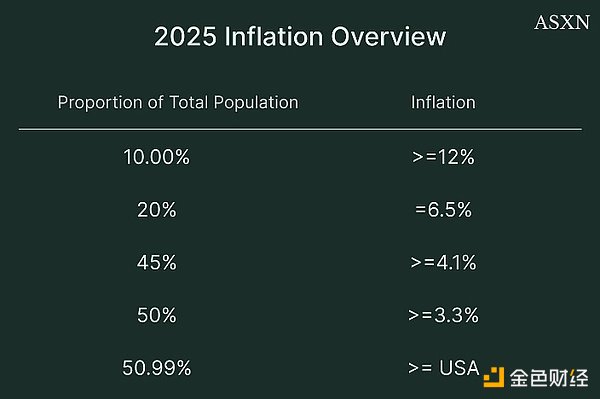
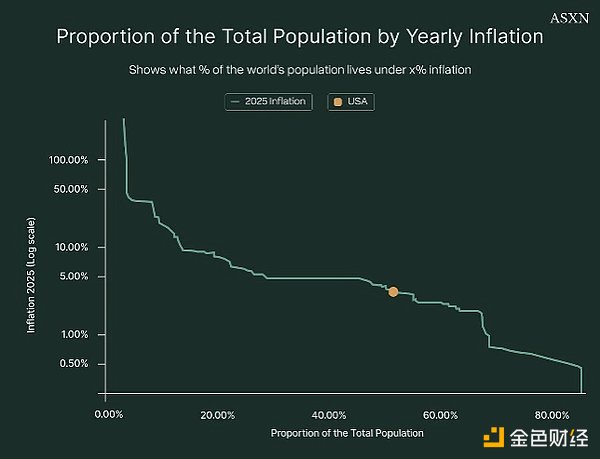
(2) Cross-Border Remittances
Remittances are an important application scenario for stablecoins. Tens of millions of workers send part of their wages back home each year, supporting over 200 million beneficiaries globally. The total amount of cross-border remittances is expected to reach approximately $905 billion in 2024, equivalent to the GDP of a medium-sized developed economy. This figure is projected to continue growing in 2025. About 76% (approximately $685 billion) flows to low- and middle-income countries (LMICs), where remittances often become the economic lifeline for these nations.
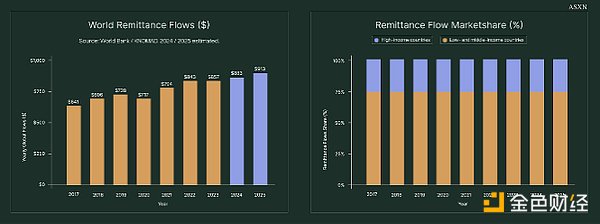
In the fourth quarter of 2023, the average cost of a $200 cross-border remittance was about 6.4%. Some remittance channels even exceed 10% in fees. For already financially constrained populations, such a high percentage of remittance amounts being eroded by fees is undoubtedly a heavy burden. These costs act like a regressive tax on the world’s poorest workers, and despite the 2030 Sustainable Development Goals calling for a reduction in global remittance costs to 3%, rates continue to climb, increasing by 3.2% year-on-year.
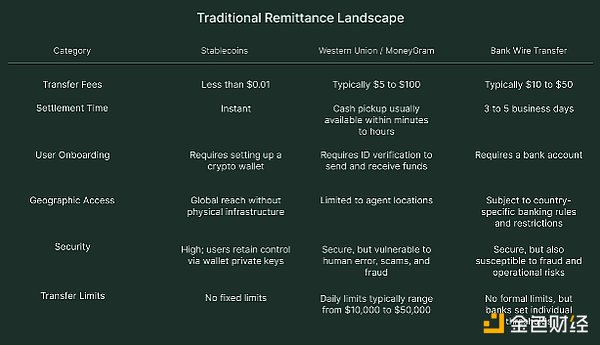
Just as the internet revolutionized information dissemination through rapid global transmission, stablecoins are achieving a similar transformation in value transfer. Stablecoins and the crypto channels they rely on provide a native internet-based solution for currency flow, characterized by speed, transparency, and low costs. Plasma will enable zero-fee USDT transfers, creating the fastest and cheapest way to circulate dollars globally. Stablecoins are suitable for remittances not only because they provide a more stable store of value (in the form of digital dollars) but also due to the inherent advantages of efficient settlement through blockchain channels.
(3) Payment Sector
While remittances constitute a distinct sub-market, the broader global payment ecosystem (covering consumer transactions, enterprise-level cash flows, public sector disbursements, emerging and embedded channels) is still grappling with traditional infrastructure. Core pain points such as high costs, slow settlement, low transparency, and weak composability permeate various fields. Despite structural inefficiencies, the global payments industry remains one of the largest sectors—processing 340 billion transactions worth $180 trillion in 2023, generating $2.4 trillion in revenue.
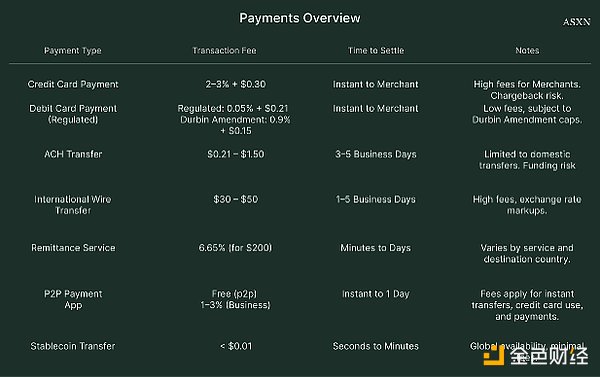
A16Z has conducted a comprehensive review of these traditional payment methods, detailing associated fees, settlement times, and operational characteristics. Compared to crypto channels, these traditional systems appear outdated, characterized by high transaction costs, slow settlement speeds, chargeback risks, closed networks, and limited accessibility.
We believe that payment based on stablecoins will most directly impact U.S. businesses, particularly those selling products to the largest consumer market (the U.S. domestic market). This is primarily due to the high penetration of credit cards in the U.S. and the associated processing fees.
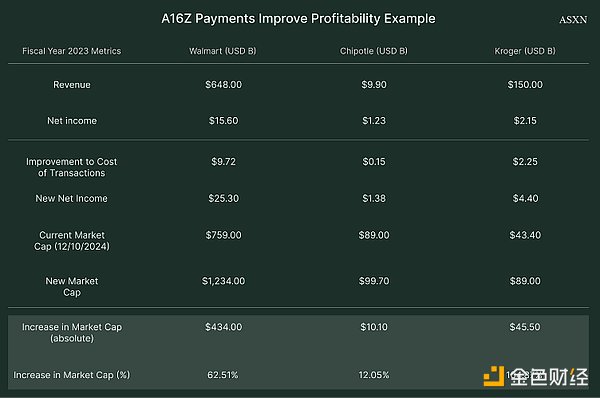
(4) Crypto Trading
As mentioned in our overview of stablecoins, these tokens initially gained attention as crypto-native collateral and settlement channels, enhancing capital efficiency for market makers and arbitrageurs. Today, trading firms and liquidity providers hold significant positions in stablecoins, while DeFi protocols embed them into collateral vaults, lending pools, and AMM trading pairs. Centralized exchanges have also shifted perpetual contracts from BTC/crypto-asset collateral to stablecoin contracts (primarily USDT trading pairs, with USDC growing rapidly), which now dominate trading volume and liquidity. In over-the-counter trading, OTC desks routinely use stablecoins to settle large transactions, and dollar-denominated tokens have become the preferred unit of account for market-neutral strategy funds and crypto credit/yield funds.
(5) Yield Generation
In addition to serving as a reliable store of value and frictionless payment medium, stablecoins also open up permissionless yield strategy channels—this is particularly significant for investors excluded from traditional markets (including U.S. capital markets).
(6) Monetary Policy
Stablecoins are becoming powerful shadow monetary policy tools, increasingly viewed by governments and treasuries as strategic means to manage sovereign debt and expand the global influence of monetary and financial systems. In Washington, as the U.S. government seeks innovative solutions to control its debt burden, this application is moving to the forefront of policy discussions.
The operational mechanism by which stablecoins assist governments in lowering borrowing costs is as follows:
As mentioned in the stablecoin section, fiat-collateralized stablecoins typically allocate most of their reserves to short-term U.S. government debt instruments: primarily Treasury bills and repurchase agreements. This strategy allows centralized issuers to earn income from customer deposits, serving both as a revenue source and, through certain models, passing some of that income to stablecoin holders.
Consequently, as the market capitalization of fiat-collateralized stablecoins grows, the demand for short-term U.S. Treasuries should increase in a nearly linear proportion. Reports from leading issuers confirm this trend: the vast majority of Tether's and Circle's current assets are government-backed instruments. Circle discloses that 88.5% of its reserves are in U.S. Treasuries, while Tether allocates about 82.2% to U.S. Treasuries, repurchase agreements, and money market fund combinations.
This new demand for government debt drives up bond prices (given the inverse relationship between price and yield), leading to lower yields. Ultimately, this allows the U.S. government to finance at lower interest rates, reducing fiscal operating costs.
The U.S. national debt is reaching unprecedented absolute levels and historical peaks relative to GDP, with peacetime budget deficits at an unprecedented scale. This dynamic drives the overall debt burden to compound growth. Meanwhile, traditional buyers of U.S. Treasuries (such as foreign central banks and reserve management agencies) have seen significant declines in demand, making relative value hedge funds the marginal price setters. However, this mechanism is becoming increasingly fragile—significant examples include the period following the Trump tariff wars, during which several relative value funds reportedly suffered massive losses, contributing to rising 10-year yields and even stock market sell-offs.
(7) Total Addressable Market (TAM) for Stablecoins
The functions of stablecoins vary by user type: for individuals in authoritarian or high-inflation economies, they provide self-custodied value storage and wealth preservation means; for others, they serve as high-speed, low-cost channels for cross-border remittances to friends and family; for businesses, they act as financial "superconductors," enabling 24/7 instant cross-border settlements at a fraction of the cost of traditional payment systems (directly enhancing efficiency and profit margins); for governments (especially the U.S. government), stablecoins are becoming powerful shadow monetary policy tools, expanding financial influence and dollar hegemony while creating new demand for U.S. Treasuries. Therefore, stablecoins touch multiple market sectors, and estimating their TAM or market capitalization growth requires numerous assumptions.
By aggregating the primary immediate use cases of stablecoins and setting reasonable assumptions for penetration rates (taking 10% here), we can preliminarily estimate the potential scale after adoption increases. Focusing on four major scenarios: offshore dollar demand, cross-border remittances, payments, and money market fund alternatives, our analysis indicates that the supply of stablecoins is expected to grow to approximately $4.9 trillion (based on moderate penetration rates).
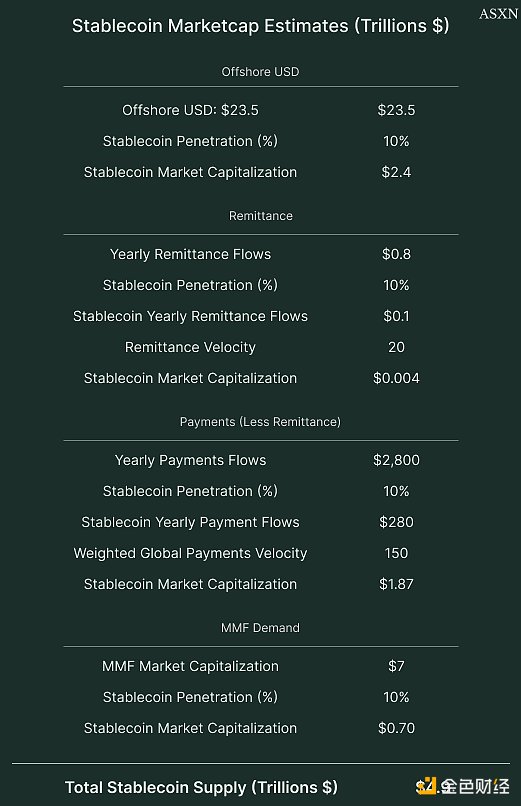
This market capitalization will grow linearly with the increase in penetration rates across various sectors, not accounting for more speculative use cases like AI-native payments.
M2 (the most widely cited measure of U.S. money supply) includes M1 (currency in circulation and demand deposits) and "near-money" instruments (such as savings deposits, small time deposits under $100,000, and retail money market funds). The current M2 size is approximately $21.86 trillion, with stablecoins accounting for just over 1.1%. As regulatory guidelines clarify, infrastructure strengthens, and the transition to fully digital payments occurs, we believe that the proportion of stablecoins in M2 is likely to grow tenfold over the next decade.
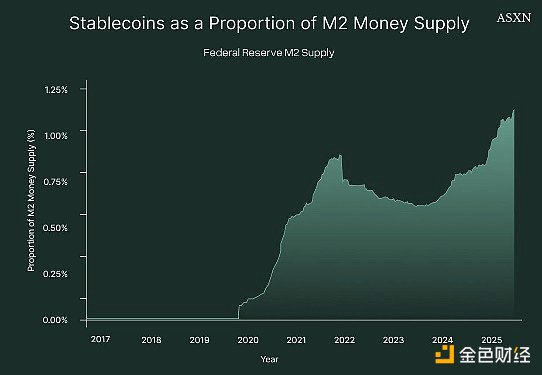
4. Plasma
Plasma combines the Byzantine Fault Tolerance (BFT) consensus protocol PlasmaBFT with an execution layer built on Reth. This chain has EVM equivalence, meaning that contracts, opcodes, and tool behaviors are entirely consistent with Ethereum. Based on EVM equivalence, the chain introduces native stablecoin functionalities: zero-fee USDT transfers and support for custom Gas tokens.
(1) PlasmaBFT
HotStuff Technical Background
HotStuff was created by VMresearch and optimized by the former blockchain team at Meta for LibraBFT. It achieves both linear view switching and responsiveness, efficiently rotating leaders while advancing consensus at actual network speeds (rather than preset timeouts). HotStuff also employs threshold signatures to enhance efficiency and allows for proposing new blocks while old blocks are still being confirmed.
However, these advantages come with specific trade-offs: compared to classic two-round BFT protocols, the additional rounds increase latency, and there is a risk of forks during the pipelining process. Despite these trade-offs, HotStuff's design supports better scalability, making it particularly suitable for large-scale blockchain applications—though the final confirmation speed is slower than that of two-round BFT protocols.
The simplified operational flow of the HotStuff protocol is as follows:
When a transaction is generated, it is sent to a validator (i.e., leader) in the network.
The leader packages these transactions into a block and broadcasts it to other validators in the network.
Validators vote to validate the block and send the voting results to the leader of the next block.
To guard against malicious behavior or communication failures, a block must go through multiple rounds of voting to achieve final state confirmation.
Depending on the specific implementation, a block must pass through two to three consecutive rounds of voting to be submitted, ensuring the robustness and security of the consensus mechanism.
PlasmaBFT Design
Compared to conventional HotStuff, PlasmaBFT has undergone several improvements. PlasmaBFT is a fast HotStuff pipeline implementation written in Rust. The protocol ensures that as long as the number of faulty validators is less than one-third, two conflicting blocks cannot be simultaneously confirmed. To finally confirm a block, at least two-thirds of the validators must approve it. Since the two-thirds majority group must overlap, there will always be common honest validators who will not sign conflicting blocks.
In the fast path, PlasmaBFT adopts a two-chain submission rule, allowing a block to be finally confirmed after obtaining two consecutive quorum certificates, rather than three. The pipelining operation allows the leader to propose a new block even before the previous block has been finally confirmed.
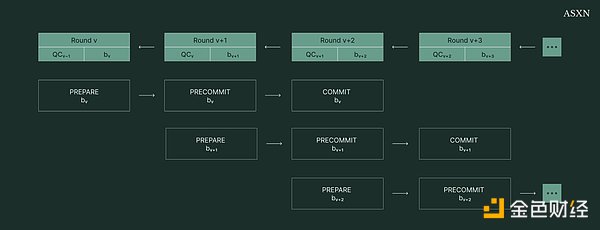
PlasmaBFT allows validators to vote through QC (quorum certificates). QC is proof that a supermajority of validators has approved a block. If validators agree, they sign the block, and when at least two-thirds of the votes are collected, these signatures are merged into a single certificate.
The QC creation process is as follows:
The leader proposes a block; validators vote by signing; after collecting two-thirds of the votes, aggregation is completed; QC is generated to prove that the block can be safely extended.
During view switching, validators send their latest QC to the new leader. The new leader aggregates these into an aggregated QC (AggQC). AggQC presents the highest security block recognized by a supermajority through a single object, preventing forks during leadership changes and reducing overhead by compressing multiple signatures into a single proof.
The incentive mechanism of PlasmaBFT is also different. It employs a reward reduction mechanism rather than a stake forfeiture system. In a stake forfeiture system, if a validator behaves improperly (double-signing, censorship, going offline), part of their staked funds will be destroyed. While this can create strong security, it carries higher risks, as even unintentional mistakes can lead to real financial losses for validators.
In PlasmaBFT, improper behavior or non-participation does not destroy the validator's staked funds but instead prevents the validator from earning rewards during that period. Rewards are only distributed to validators who actively participate and follow the rules. If a validator fails to sign a block, signs a conflicting block, or is negligent, they will not receive rewards.
PlasmaBFT does not require every validator to vote on every block; instead, a smaller committee is formed for each round. The committee is selected through a stake-weighted random process, reducing the number of nodes that need to exchange votes, thereby lowering latency and communication costs. Plasma also deploys non-validator nodes—these nodes do not participate in consensus but follow the final confirmation chain of validators and provide RPC access for applications and users.
(2) Execution Layer (Reth)
Plasma uses Reth (Rust ETH), developed by Paradigm, as the execution client. Reth is an EVM re-implemented in Rust, responsible for processing transactions, executing contracts, and updating states. Plasma has EVM equivalence, so each opcode and precompiled contract behavior is consistent with the Ethereum mainnet.
Reth connects to PlasmaBFT through the Engine API. This interface implements the following functions:
The consensus client submits new block proposals to the execution client for processing;
The execution client executes transactions within the EVM, updates the state, and returns results;
The consensus client requests block data packets from the execution client when proposing new blocks;
Both components synchronize and maintain consensus on valid blocks and final confirmed blocks.
PlasmaBFT is responsible for proposing and finally confirming blocks, which are then passed to Reth. Reth sequentially applies transactions and updates the state root. This architecture follows the consensus-execution separation model adopted after Ethereum's merge.
Reth is built in a modular fashion. It separates the transaction pool, block construction, execution, and storage into independent components: the transaction pool temporarily holds pending transactions, the block builder filters and packages transactions, the execution engine applies EVM rules to update the state, and the storage module tracks account balances, contract code, and contract storage.
Reth also employs a phased synchronization mechanism to download on-chain data. This means it processes block headers, block bodies, and state data in phases rather than all at once. This approach reduces memory and disk requirements and accelerates the initial synchronization process.
(3) Plasma Native Features
Plasma integrates stablecoin-centric functionalities at the protocol layer, including zero-fee USDT transfers, support for custom Gas tokens, and confidential transfers (under development).
Before discussing zero-fee USDT transfers and custom Gas tokens, it is necessary to briefly explain paymasters and the EIP-4337 standard.
Paymasters are smart contracts that support flexible Gas strategies, such as allowing applications to pay transaction fees on behalf of users (theoretically enabling free transactions) or accepting ERC-20 tokens (like USDC) instead of native blockchain tokens for Gas payments. Paymaster smart contracts were initially introduced by EIP-4337, with the core value of improving user onboarding experiences, enabling convenient Gas strategies, and providing higher programmability for transactions.
EIP-4337 introduces a model that separates user operations (UserOp) from conventional transaction processing: Bundlers aggregate these operations into blocks, and Paymasters validate and pay for Gas according to rules. Paymasters perform eligibility checks through the validatePaymasterUserOp function to ensure costs are controllable and assume responsibility for Gas payments.
In Plasma, the Paymaster model is applied in two ways: one implements zero-fee USDT transfers, and the other supports custom ERC-20 token payments for Gas.
Zero-Fee USDT Transfers
Plasma implements a paymaster managed by the protocol based on EIP-4337. This paymaster only supports the transfer and transferFrom methods in the official USDT contract and cannot sponsor arbitrary call data or general transactions. The Gas fees for related operations are prepaid by the Plasma Foundation.
To prevent abuse, the paymaster implements authentication and frequency limits. Only verified users can enjoy this subsidy, and there is a usage cap for each wallet. This ensures that the free transfer mechanism is not abused indefinitely. This was one of the main concerns when Plasma announced free transfers—while theoretically any transaction on the blockchain could be free (assuming no incentive issues for validators/miners), Gas fees still need to be charged to prevent spam transaction attacks.
Currently, there are proposals to reserve block space for these transfers. One proposal is to mark eligible USDT transfers in the memory pool and modify the block builder to prioritize allocating part of the block's Gas capacity to such transactions; any unused reserved space will revert to regular transactions. Any EVM-compatible wallet can support these gas-free USDT transfers without modification, while also being compatible with EIP-4337 smart accounts and standard wallet processes.
Custom Gas Tokens
Plasma also supports the use of approved ERC-20 tokens to pay fees, a feature managed by a paymaster operated by another protocol. The operational process is as follows:
Users select supported tokens;
The Paymaster prices the Gas fees using oracle data;
Users authorize the paymaster to use that token;
The Paymaster pays the consensus Gas fees in native tokens while deducting an equivalent amount of ERC-20 tokens from the user's account.
The custom Gas paymaster and the zero-fee USDT paymaster operate independently: the USDT paymaster subsidizes Gas costs, while the custom paymaster accepts ERC-20 tokens as an alternative to Gas payments. This mechanism allows users to avoid holding XPL. Initially supported tokens include USDT and pBTC, with plans to expand to more tokens. Only tokens approved by the protocol are accepted.
Confidential Transfers
The USDT confidential transfer feature is still under research and has not yet been implemented. Its goal is to provide optional privacy protection while maintaining EVM compatibility and composability.
The design aims to support the following features:
Hiding transfer amounts and recipient addresses;
Encrypted memos accompanying transactions;
Private-to-public and public-to-private transfer channels;
Selective disclosure (for audit or regulatory compliance).
As this module is in active research, specific details have not yet been finalized. The ultimate goal is to make confidential transfers similar to the experience of conventional ERC-20 transfers at the user, application, and wallet levels, allowing existing contracts and wallets to interact seamlessly. Additionally, the Plasma team hopes to ensure efficient implementation (low computational load and Gas costs) with optional usage. The team has already indicated that they are exploring potential paths such as stealth addresses (sending funds to one-time derived addresses), memo encryption, indexing methods, and proof systems.
(4) Plasma One
As mentioned earlier, in countries with weak currencies and strict capital controls, individuals and businesses are turning to stablecoins pegged to the dollar as a means of value storage. In economies like Argentina, Turkey, Lebanon, Venezuela, and Nigeria, people are saving in digital dollars primarily based on USDT rather than holding rapidly depreciating local currencies. In such environments, the function of stablecoins is closer to that of digital savings accounts rather than payment channels, providing a more stable option for maintaining purchasing power. Typically, these users prefer to use centralized exchanges for sending, receiving, and growing their digital dollars.
However, there is also a growing number of mature users in the market who wish to manage stablecoins in a self-custodial manner. Over the past year, we have witnessed a wave of crypto card and digital banking providers emerging.
Traditional digital banks (like Revolut) often impose strict labeling on crypto deposits and withdrawals or charge high fees and spreads. Meanwhile, most crypto digital banks and crypto cards are disconnected from the DeFi ecosystem, making it difficult for funds to enter and exit practical ecosystems and products, thus missing out on yield, rewards, and vault opportunities. Plasma One enables Plasma to provide banking and payment services that can effectively utilize DeFi protocols. While most emerging market users may continue to use centralized exchanges for payment transactions, we believe Plasma One offers these users a potential alternative while also providing a digital banking solution integrated with DeFi for mature users.
Native Digital Banking for Stablecoins
Plasma One is a non-custodial, stablecoin-native digital banking and card product that integrates savings, spending, yield, and transfer functionalities into a single platform. Its goal is to package core financial services around stablecoins into one application, allowing users to treat digital dollars as regular currency.
The core feature of Plasma One is the ability to spend directly from a stablecoin balance that continuously generates yield. Users can use funds for payments while these funds remain interest-bearing before consumption, claiming yields of 10% or higher. Additionally, spending through the Plasma One card can earn up to 4% cashback (issued in XPL).
The card will be available globally in over 150 countries through the Visa network. Transfers within the Plasma system are promoted as free, allowing users to send USDT instantly at no cost, although the company notes that third-party fees may still apply depending on the path taken.
(5) pBTC
Overview:
pBTC naturally aligns with Plasma's goal of becoming a crypto-native digital bank (Plasma One) by reinforcing the platform in two key ways:
First, it introduces Bitcoin as a corresponding asset to stablecoins in payment and savings scenarios.
Second, it enables BTC to circulate on Plasma, serving as collateral, facilitating transfers, and integrating into various DeFi applications.
The core value of BTC on pBTC lies in its role as collateral. Historically, users have always sought liquidity while maintaining exposure to Bitcoin. Through pBTC, users can stake their held BTC and borrow stablecoins or other assets, creating funds available for consumption or reinvestment without selling their underlying Bitcoin positions.
Users also seek ways to accumulate more Bitcoin, typically through custodial products (like cbBTC) or direct operations on the Bitcoin native chain. However, cbBTC requires users to fully trust Coinbase's reserve security management and redemption guarantees, posing a single point of failure risk. Such custodial control may also lead to potential freezes or restrictions based on compliance or operational decisions. The Bitcoin native chain itself has limitations, lacking DeFi functionalities that support programmable financial activities like lending.
In addition to Bitcoin's productive use, pBTC allows users to access harder currency assets. Crypto assets have proven their irreplaceable value to people in high-inflation, capital-controlled, and poorly governed central bank countries through digital dollar channels. Bitcoin extends this concept, providing protection against currency depreciation even in developed economies. While the dollar remains the dominant unit of account and medium of exchange, its purchasing power continues to face inflationary pressures. Concerns over high government debt raise questions about the long-term stability of the dollar—massive debt often forces governments to raise taxes, cut spending, or accept higher inflation to erode the real value of debt. This ongoing inflation risk drives some savers toward assets that cannot be arbitrarily inflated. Due to their fixed or limited supply characteristics, Bitcoin and gold attract those concerned about currency depreciation, establishing their status as "hard" assets in uncertain monetary environments.
pBTC Mechanism:
pBTC aims to bring native Bitcoin into the Plasma network without relying on centralized custody or fragmented wrapped assets. Unlike existing Bitcoin representation schemes like wBTC that depend on custodians to issue chain-specific wrapped tokens, pBTC implements the LayerZero's Omnichain Fungible Token (OFT) standard. This ensures that pBTC operates as a single asset with a unified supply, seamlessly circulating across multiple LayerZero interconnected chains, rather than existing as independent token contracts on each network. Notably, pBTC operates as an interchangeable ERC-20 token, but the OFT framework guarantees its direct transfer to other LayerZero interconnected chains without the need for re-wrapping or copying liquidity pools.
The pBTC architecture consists of three core layers: in the custody layer, users deposit BTC into a collectively controlled address managed by the system, with withdrawals managed through a threshold signature (MPC/TSS) mechanism to prevent any single validator from accessing the signing keys; the validator network forms the second layer, with each validator running an independent Bitcoin full node and indexer, monitoring deposit and withdrawal operations and publishing proofs after transaction finality, which are stored on-chain and require a quorum to execute operations; the final issuance layer handles pBTC minting, where an equivalent amount of pBTC is directly minted on Plasma and linked to the user's mapped address after a sufficient number of proofs confirm the deposit.
The following simplified transaction lifecycle demonstrates the actual operation process of pBTC:
Deposit Process:
When users deposit, they send BTC to the Plasma treasury address;
Each validator independently monitors Bitcoin network transactions, broadcasting proofs after confirming finality;
Once a supermajority consensus is reached, Plasma mints the corresponding pBTC to the user's wallet.
Withdrawal Process:
When users withdraw, they destroy pBTC on Plasma and specify the target Bitcoin address;
After the validator confirms the destruction operation, the Bitcoin transaction is collectively signed through MPC/TSS;
BTC is only released to the user on the underlying chain when a supermajority consensus is reached.
Although OFT still uses a burn-mint mechanism to maintain global supply, it has key differences from traditional cross-chain bridges: first, traditional bridges typically issue independent wrapped assets on each chain, leading to fragmented supply and liquidity, and often rely on custodians or small multi-signature controls to lock collateral; whereas OFT treats tokens as a unified global supply, utilizing LayerZero messaging to achieve cross-chain state transfer. The token issuer retains direct control over the contract and parameters, and this standard is designed specifically for multi-chain rather than bridging modifications.
Since pBTC exists across chains with a unified supply, liquidity will not be fragmented due to multiple versions of wrapping. Withdrawals are secured through a supermajority threshold signature, replacing the single custodian model to weaken unilateral control. Additionally, all validation events are stored on-chain for auditing by any participant.
5. Token Economics
(1) Token Utility
XPL is the core asset that secures L1 through a Proof of Stake (PoS) mechanism, used to facilitate transactions and reward users who support the network by validating transactions. XPL ensures the integrity of this new system and coordinates long-term incentives as the adoption scale of stablecoins expands.
(2) Token Supply
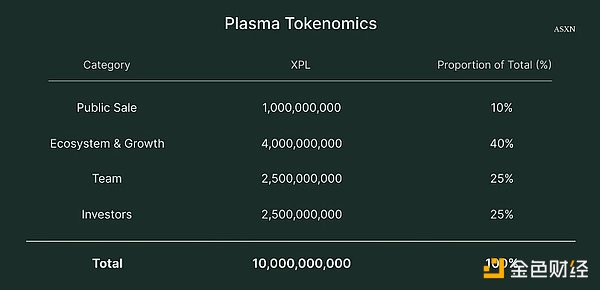
The initial supply at the launch of the mainnet test version is 10 billion XPL, with subsequent programmatic issuance for staking (inflation) to be introduced. The initial XPL allocation ratio is as follows:
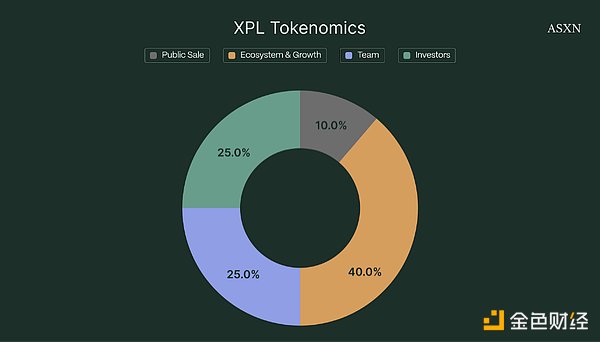
XPL Public Offering (10%) — On May 27, 2025, the Plasma team announced the XPL public offering plan, allocating 10% of the total supply (1 billion XPL) to participants in deposit activities. Users who pre-deposit stablecoins into Plasma at a valuation of $500 million will proportionally purchase $50 million worth of XPL. The unlocking rules for public offering XPL are as follows:
XPL purchased by non-U.S. buyers will be fully unlocked at the launch of the Plasma mainnet test version;
XPL purchased by U.S. buyers will have a 12-month lock-up period and will be fully unlocked on July 28, 2026.
Ecosystem and Growth (40%) — The Plasma team "plans to leverage XPL to enhance network effects, covering not only the crypto-native ecosystem but also penetrating traditional finance and capital markets," thus allocating 40% of the supply to strategic growth plans aimed at expanding the utility, liquidity, and institutional adoption of the Plasma network. The unlocking arrangements for these tokens are as follows:
8% of the XPL supply (800 million) will be immediately unlocked at the launch of the mainnet test version for DeFi incentives for strategic partners, liquidity needs, exchange integration support, and early ecosystem growth activities.
The remaining 32% (3.2 billion XPL) will be unlocked monthly in equal proportions over the next three years, ensuring that 100% of the ecosystem and growth allocation is fully unlocked on the third anniversary of the mainnet test version's public launch.
Team (25%) — 25% of the XPL supply (2.5 billion) is allocated to incentivize existing and future service providers. In addition to a vesting plan tied to the date of joining, the unlocking rules for team allocations of XPL are as follows:
One-third of the team tokens will have a one-year cliff period starting from the public launch of the Plasma mainnet test version.
The remaining two-thirds will be unlocked monthly in equal proportions over the following two years, ensuring that 100% of the team allocation is fully unlocked on the third anniversary of the mainnet test version's public launch.
Investors (25%) — 25% of the XPL supply is allocated to Plasma institutional and community investors, including institutions such as Founder's Fund, Framework, Bitminex, and the first round of Echo sales aimed at private investors.
(3) Release and Inflation Plan
At the TGE, the initial circulating supply of XPL accounts for only about 18% of the total supply, with the remaining supply locked according to the vesting plan. The initial token supply comes from the public offering allocation and the 8% share in the ecosystem and growth allocation. Therefore, the supply composition at TGE is as follows:
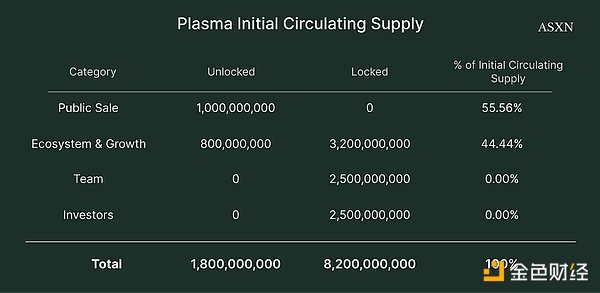
Note: This calculation assumes that 100% of the public offering share is purchased by non-U.S. citizens and is unlocked immediately at TGE. The actual situation may vary since the portion purchased by U.S. citizens needs to be locked for one year, resulting in a lower initial circulating supply. For example, if 10% of the sales come from KYC-verified U.S. accounts, the supply at TGE would be: 1 billion * 90% + 800 million = 1.7 billion XPL.
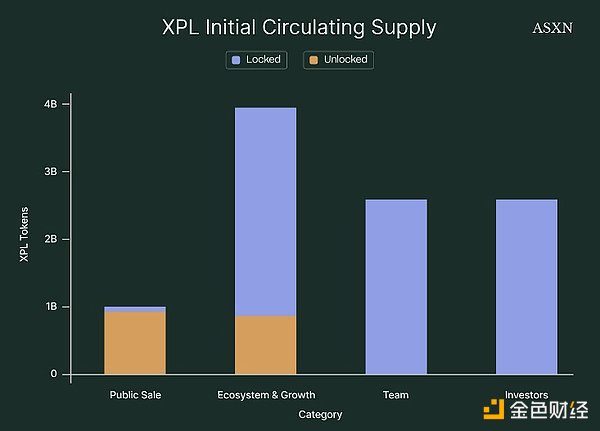
In terms of the vesting period, the team and investors follow the same liquidity release path, while the ecosystem and growth allocation will be gradually unlocked over three years according to a linear schedule. The results are as follows:
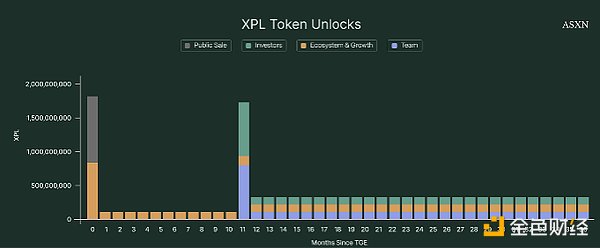
As Plasma adopts a PoS consensus mechanism, validator rewards are typically minted by the protocol to achieve two goals: (i) ensure that the validator economic model is attractive to top participants to secure network safety; (ii) minimize the long-term dilution effect on XPL holders. Therefore, the initial annual inflation rate for XPL rewards is set at 5%, decreasing by 0.5% each year to a baseline of 3%, and will only be activated after external validators and staking delegation features are launched.
The emissions are distributed to stakers by validators, and the locked XPL of the team and investors do not participate in the reward distribution. To offset the dilution effect, Plasma adopts the EIP-1559 model to permanently burn base transaction fees: establishing a balance between new token emissions and network usage. More details regarding validator rewards will be announced before the inflation mechanism and reward system are activated.
6. DeFi Ecosystem
Plasma appears to adopt a three-pronged growth strategy to achieve its ultimate goal: to settle dollar transaction volumes that surpass any global blockchain or payment company. This report delves into these three dimensions:
(1) Tapping into the Existing USDT User Base:
The dollar stablecoin market has reached $292 billion, growing by 69.7%, and has increased 70-fold since the beginning of this decade. This unimaginable rapid growth indicates that supply may reach trillions of dollars in the coming years. By offering zero-fee USDT transfers, Plasma can quickly penetrate the existing Tether supply ($170 billion) and capture market share from public chains that fail to provide a smooth experience for users who merely hold funds, make payments, and transfer dollars. According to Chainalysis data from August 2025, 40% of blockchain-based transaction fees are used for simple USDT transfers.
(2) Expanding Market Capacity and Accessing Underbanked Groups:
Globally, about 30% (2.4 billion people) lack access to basic and affordable financial services, including transactions, payments, savings, and credit. While there is a clear learning curve associated with using stablecoins, it is likely the simplest and fastest way for people to access three of these four services in dollar form (with credit still needing improvement). Distribution channels, user experience, and a broad ecosystem of financial primitives are the three factors hindering Plasma from promoting this less exploitative and less restrictive platform to hundreds of millions of users. Accessing Plasma means self-custody, access to a wide range of real-world assets, and 24/7 fee-free transactions.
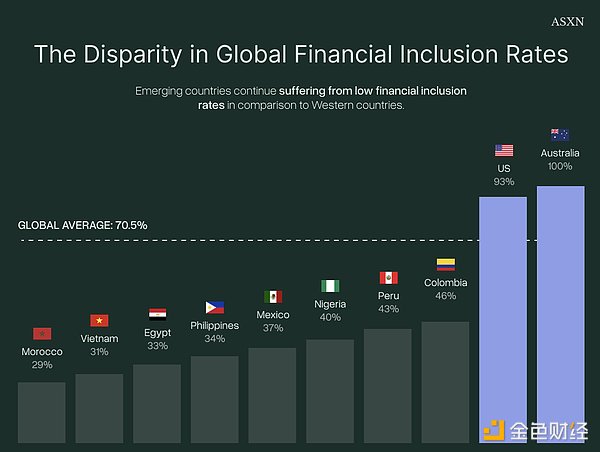
(3) Building an On-Chain Economy for Crypto-Native Users and Investors
Veda, Binance Earn, and Maple attracted nearly $3 billion in total USDT locked on their launch day. Whether these funds can be deployed with attractive yields and attract subsequent inflows of hundreds of billions into the ecosystem will entirely depend on Plasma's ability to build a complete DeFi ecosystem. We will analyze Plasma's launch partners in detail in the next chapter and explore the current deployment models of productive capital in the crypto space.
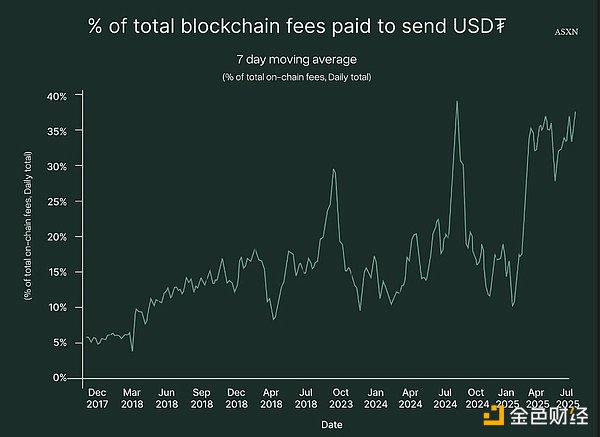
Having numerous first-launch applications on L1 is clearly insufficient to differentiate from competitors like Solana, Ethereum, Tron, and Hyperliquid. Plasma's opportunity lies in providing a complete monetary experience from receiving payments, bill payments, to savings and investment. This end-to-end experience means that Plasma can serve not only those lacking basic financial services but also meet the needs of crypto-native users and a broader range of investors.
Over the past five years, other public chains have made significant progress in throughput and user experience, which is part of the reason for the stablecoin market cap growing by hundreds of billions year after year. However, we firmly believe that improvements in areas such as wallet security, smart contract robustness, and quality asset issuance in the coming years will be key to driving stablecoins to become a $3 trillion market, and Plasma will be in the best position to capture this growth.
In our previous Plasma special report, we mentioned that the CEO of PayPal focused on the issue of its platform being unable to retain funds within its internal system. In 2024, its 430 million active users completed 26 billion transactions, totaling over $1.7 trillion, but recipients (whether person-to-person or person-to-business) often immediately withdraw funds to their bank accounts. This is quite reasonable, as users need to actually utilize these funds for consumption, earning interest/investment, and paying bills. The following sections will elaborate on Plasma's plan: to allow everyone to use a top-tier payment system (similar to a PayPal experience) while meeting most of their financial needs on a single network.
(4) Day1 DeFi Ecosystem
In the coming weeks, Plasma will host billions of dollars in USDT supply. The network is designed from top-level architecture to bottom-level infrastructure to attract and retain stablecoin inflows. In recent weeks, we have witnessed Plasma establishing partnerships with several successful protocols across ecosystems (Aave, Maple, Veda, Uniswap, Pendle, etc.). Focusing on the synergy between core primitives and launch partners, precise DeFi incentive activities are expected to be achieved—just as "8% of the XPL supply (800 million) will be immediately unlocked at the launch of the mainnet test version for DeFi incentives for strategic partners, liquidity needs, exchange integration support, and early ecosystem growth activities." So, what elements are needed to build a self-sustaining DeFi ecosystem?
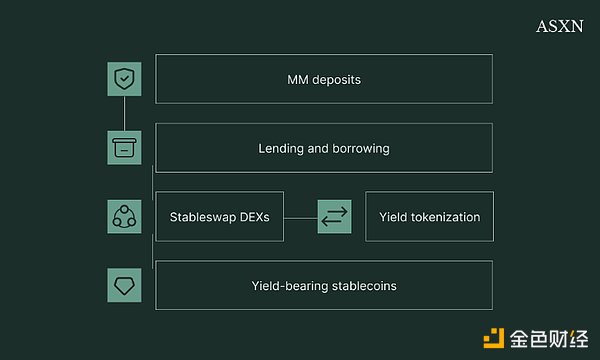
Asset Issuance, Credit, and Inflow Drivers
In addition to USDT, Plasma will support a wide range of long-tail stablecoins and tokenized treasury products, including important launch partners such as Ethena, Centrifuge, USD.ai, Neutrl, Resolv, and Clearpool. Given the rapid growth of USDe, Ethena needs to continuously generate a large amount of USDT/liquidity stablecoin deposits to earn yields and ensure users can withdraw seamlessly, avoiding liquidation at non-ideal times. This will become a "black hole" for hundreds of millions of USDT and BTC on Plasma.
Binance Earn and Plasma are jointly launching an initiative to provide Binance's 280 million users with the opportunity to enhance their over $30 billion USDT within the Plasma ecosystem, allowing users to earn on-chain yields and XPL incentives.
Maple (TVL over $4 billion) is launching the syrupUSDT treasury, which will bring $200 million in deposits to Plasma upon launch. The treasury is fully subscribed at launch, indicating high demand for XPL incentives and enthusiasm for transferring stablecoins to Plasma. Maple provides over-collateralized loans to crypto-native businesses in need of short-term financing.
Centrifuge (TVL over $1.2 billion) offers on-chain access channels for tokenized assets, particularly government bonds and credit funds. Given the depth of the U.S. Treasury and the broader AAA-rated bond market, these tokenized treasuries almost provide unlimited exposure to yields of 4-5%. This will become an excellent market for non-U.S. investors to access the safest on-chain lending opportunities.
USD.ai (TVL $750 million, Plasma exclusive quota $500 million) is a relatively emerging protocol that provides hardware (GPU) financing services for AI companies. Borrowers can tokenize these GPUs through bankruptcy-remote SPVs and borrow from USD.ai treasury depositors, paying a compensation several percentage points above risk-free rates. Given the recent growth in the AI sector, it is predictable that the demand for GPUs and physical hardware financing will continue to grow exponentially. There are clearly different off-chain risks here, but it provides another liquidity pool for stablecoins seeking yields within Plasma.
Several key pre-release protocols are about to land on Plasma and should receive significant XPL incentives:
Axis is an on-chain treasury that allows depositors to enjoy the profits from arbitrage across different trading venues.
Daylight is a renewable energy company aiming to reduce solar installation costs through the on-chain economy and ultimately create a trading market for green electricity generated by decentralized grids.
Uranium Digital is a 24/7 operational institutional-grade uranium trading platform.
The Plasma team plans to continuously promote credit opportunity exploration, creating new opportunities for on-chain stablecoin holders within months of launch.
Liquidity and Trading
If Plasma's vision is realized, there will be thousands of stablecoins targeting different fiat currencies, each with different yield characteristics and trust assumptions. The ability to exchange assets or currencies with minimal or zero price impact is crucial for attracting high-net-worth users to the ecosystem.
At launch, Uniswap, Curve, Fluid, and Balancer will deploy professional pool management to support stablecoin exchanges, ensuring that on-chain users can enter and exit stablecoins at any time at pegged prices. Plasma commits to directing tens of millions of dollars worth of XPL incentives to different USDT pools within six months, ensuring that XPL, ETH, weETH, XAUT, and several long-tail stablecoins mentioned above enjoy permanent liquidity.
On-Chain Leverage
Plasma's DeFi ecosystem needs to balance an important scale: providing stablecoin holders with sufficiently high yields to attract them into the network while ensuring that borrowers can obtain competitive rates to participate in Plasma DeFi. The key lies in finding yield-driving sources outside of on-chain leverage demand and incentivizing Aave deposits with sufficient XPL to encourage users to migrate positions from Ethereum. We believe that the launch of Ethena and Plasma One will bring massive supply-side liquidity to lending protocols—Ethena needs to activate stablecoin balances to avoid dragging down yields, while Plasma One card users are eager to earn 4-5% on stablecoin balances. As Plasma's DeFi lead stated, "This is where borrowers and lenders meet."
The most trusted on-chain lending platform, Aave (TVL $69 billion), will support the DeFi ecosystem from day one. Euler, Fluid, and Wildcat will also serve as launch partners, bringing permissionless markets, under-collateralized loans, and other borrower-oriented lending features to the network.
Treasuries and Yield Management
Yield management and active DeFi treasuries have seen significant growth in recent years, and given the ample supply of stablecoins within the Plasma ecosystem, they will play an extremely important role. Pendle and Veda, as launch partners, bring highly customized solutions for yield generation within the Plasma ecosystem.
Veda: A non-custodial DeFi treasury curation protocol for automating and optimizing on-chain capital allocation. It allows capital providers to passively earn top yields without continuously managing positions across dozens of protocols. By deploying passive capital to the highest risk-adjusted yield pools at any given moment, it maintains the efficient operation and balance of the DeFi ecosystem.
Pendle: A tokenized yield trading platform that allows traders to speculate on the future returns of yield-generating assets. If speculators believe that asset returns will exceed Pendle's market pricing, they can lock in fixed returns on yield-generating assets by purchasing future yield rights.
The combination of these two partners builds a Plasma ecosystem that meets the needs of both mature/active traders and more passive DeFi users (who may only use Plasma for payments and savings). By combining top yields with a feature-rich DeFi ecosystem, Plasma truly possesses the strength to compete with top Layer 1 public chains.
7. Core Arguments
(1) Stablecoin Supercycle
Stablecoins are becoming the cornerstone of the new financial system. They offer faster settlements, lower transaction costs, seamless cross-border functionality, programmability, and auditability. Their adoption speed is astonishing: as mentioned above, the market size has grown from $30 million in 2018 to over $250 billion today, with a compound annual growth rate of 263%. Initially, they were mainly used in crypto-native scenarios: market makers and arbitrageurs used them as collateral and settlement assets, foundational assets in DeFi collateral structures, or exchanges for stablecoin margin trading.
However, their use cases have transcended the crypto-native realm. People in countries with high inflation or economic instability are increasingly using stablecoins as a means of value storage, while the remittance market adopts them for low-cost, near-real-time cross-border payments. Improvements in infrastructure support this trend, including efficient fiat channels, low-cost public chains, and better wallet solutions.
The market is expected to continue growing to a trillion-dollar scale. This is primarily due to its development intertwining with the global macroeconomy: stablecoin reserves increasingly include U.S. Treasuries, making issuers a structural source of demand for government debt. Currently, stablecoins rank as the 15th largest holder of U.S. Treasuries, with an exposure of approximately $193 billion.
Policymakers have recognized their strategic value. Stablecoins are seen as tools to reinforce dollar hegemony, manage sovereign debt, and solidify the financial system. Bipartisan efforts in the U.S. are advancing legislative regulation of issuance and reserves, with the House-led "STABLE Act" and the Senate's "GENIUS Act" both establishing a compliance framework for dollar stablecoins. These developments indicate that regulatory clarity is imminent, which will further drive stablecoin growth. Plasma is positioned as a customized public chain optimized for stablecoins and will undoubtedly benefit from this growth trend.
(2) Ethereum and Tron Not Built Specifically for Stablecoins
Currently, most stablecoins exist on Ethereum and Tron, but neither public chain is tailored for them. Ethereum is constrained by high transaction fees (during peak times), while Tron faces both high fees and centralization issues. Both limit the potential of stablecoins as efficient transfer systems.
This opens up space for dedicated infrastructure. Plasma addresses these pain points by offering zero-fee USDT transfers. With an existing Tether supply of $170 billion, there is a significant opportunity to attract user traffic currently bearing unnecessary costs. As of August 2025, 40% of blockchain-based transaction fees are used for simple USDT transfers. Plasma's model directly targets this inefficiency, providing a smoother and more cost-effective experience for payments and transfers.
(3) Crypto-Native Digital Banking
Plasma One is designed as a digital bank native to stablecoins. It integrates savings, consumption, yield, and transfer functions into a single non-custodial application, allowing users to treat stablecoins as regular currency. This positions Plasma as a full-service platform rather than just a payment channel.
The market has also seen a surge of mature user groups hoping to manage stablecoins in a self-custodial manner. In the past year, several crypto card and digital banking providers have emerged to meet this demand. Traditional digital banks (like Revolut) often mark or restrict crypto-related transfers and charge high fees and spreads. Meanwhile, most crypto-native digital banks and card products remain disconnected from the DeFi ecosystem, limiting users' ability to invest funds into productive ecosystems that offer yields, rewards, and treasury strategies. Plasma One fills these gaps by enabling backend direct connections to DeFi protocols for banking and payment services, allowing users to maintain self-custody of their assets while accessing a broader range of financial opportunities.
Stablecoins themselves open up permissionless access to diversified yield strategies. Yields can come from government bond holdings, stablecoin pool liquidity provision, lending markets, perpetual contract arbitrage, and other structured strategies, as well as private credit markets.
Currently, DeFi is concentrated on Ethereum, where high costs and complexity limit accessibility. In contrast, integrating DeFi into an L1 public chain linked to digital banking can simplify access, integrate financial services, and expand participation. Early-stage incentives may drive user growth. Plasma's strategy allows it to serve both mature crypto-native investors and a broader market, combining traditional financial primitives with integrated DeFi yields on a single platform.
(4) Payments and Cross-Border Remittances
Stablecoins provide an internet-native alternative for the flow of funds. They enable near-instant settlements, are available 24/7, and cost significantly less than traditional systems. In comparison, the global average cost of a $200 cross-border remittance reached 6.4% by the end of 2023, with some channels exceeding 10%. These fees impose a regressive burden on laborers who rely on remittances. On public chains, transaction costs are measured in cents or smaller units: for example, the recent average fee on the Base chain was only $0.00024, while Ethereum's was $0.155. Plasma plans to further reduce costs, achieving zero-fee transfers for USDT.
Remittances are particularly important in emerging markets, where centralized exchanges often become the primary channels for sending and receiving funds. Plasma's integration with Binance directly addresses this behavior pattern. Through joint initiatives, Binance's 280 million users can invest over $30 billion in USDT into the Plasma ecosystem, enjoying on-chain yields and incentives while benefiting from lower transfer costs. This creates a direct entry point for emerging market users who have relied on CEX platforms and may expand services through the Plasma One application.
The role of stablecoins in these markets goes beyond payments. Over 20% of the global population lives in environments with inflation rates exceeding 6.5%, with more than half facing inflation more severe than that of the United States. The digital dollar has become a savings tool for grassroots communities. In countries like Argentina, Turkey, Lebanon, Venezuela, and Nigeria, individuals and businesses increasingly use stablecoins to combat local currency volatility and maintain purchasing power. In this context, the function of stablecoins is more akin to that of digital savings accounts rather than a medium of exchange.
免责声明:本文章仅代表作者个人观点,不代表本平台的立场和观点。本文章仅供信息分享,不构成对任何人的任何投资建议。用户与作者之间的任何争议,与本平台无关。如网页中刊载的文章或图片涉及侵权,请提供相关的权利证明和身份证明发送邮件到support@aicoin.com,本平台相关工作人员将会进行核查。




